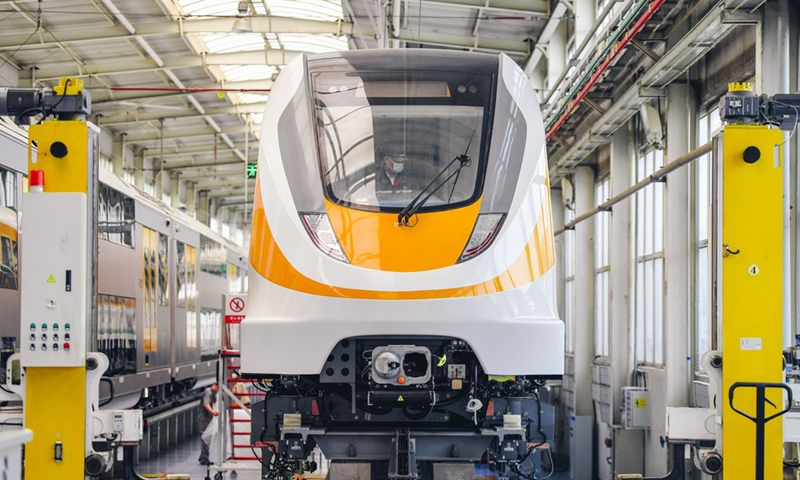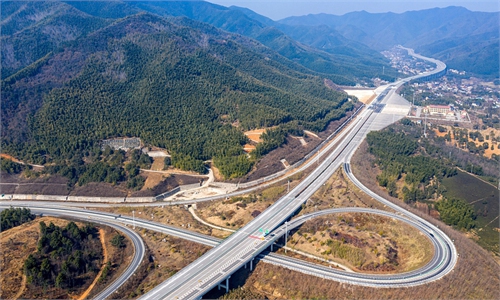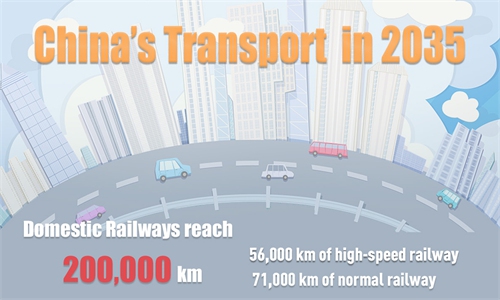China plans to be transport powerhouse, fueling GDP growth
Better roads, rail system will fuel GDP growth, close urban-rural gap

A staff member tests a middle-to-low-speed maglev train at CRRC Changchun Railway Vehicles Co., Ltd. in Changchun, northeast China's Jilin Province, April 29, 2020. (Photo: Xinhua)
China will become a transportation powerhouse that "will leap to the front ranks of the world" by 2035, a government official told the media on Wednesday, while a stronger infrastructure buildup will fuel economic growth in the post-pandemic era and help narrow the urban-rural gap, experts said.
Deputy Transport Minister Wang Zhiqing said that China will "speed up construction of a transportation powerhouse" in the next 15 years. By the end of 2035, China will join the ranks of countries with strong transportation networks, he said.
The ministry will implement major engineering projects and key transportation missions listed in the country's 14th Five-Year Plan (2021-25), which emphasized that China should upgrade high-speed railway and rail equipment manufacturing.
Detailed plans have been laid out. The government recently published an outline for building a national comprehensive transportation network, which noted that China will build 700,000 kilometers of transportation networks - including railways, roads, airports and commute hubs - by the end of 2035.
Wang also said that China will push transportation connectivity in the southern Greater Bay Area, while speeding up constructing an unimpeded transportation network in South China's Hainan Province.
These are signals that China, whose massive input in infrastructure has been one of the strongest engines to propel economic growth during the past decade, will not slowdown the impetus in the next years. However, experts said that the government will adjust the pace of infrastructure investment growth in line with economic changes.
"The growth of infrastructure input might slow down a bit this year as a result of inflation and rapid GDP growth, but it will likely accelerate again next year to support the economy. In total, incremental infrastructure input from 2021 to 2025 should reach a record high," Tian Yun, vice director of the Beijing Economic Operation Association, told the Global Times on Wednesday.
Cong Yi, a professor at the Tianjin University of Finance and Economics, said that China's input in infrastructure projects will support GDP growth and resolve bottlenecks in economic development such as urban-rural gaps.
"China's infrastructure development still has a lot of room for improvement. For example, the plans to launch smart cities mean that transportation systems will have to install smart devices. Therefore, China's infrastructure construction spending won't be like a flood. Instead, it will tilt toward high technologies," Cong said.
China's plan to strengthen infrastructure construction also coincides with a move by the US government intended to stimulate the economy via infrastructure investment, as the Biden administration is reportedly crafting a package that could cost as much as $3 trillion for infrastructure.
The first part of the proposal would incorporate $1 trillion spending on infrastructure projects like roads, bridges, railways, ports and the electric grid. It will also incorporate investment in clean energy, manufacturing and high-tech industries like 5G, fortune.com reported.
The infrastructure plan should be another major stimulus to the economy following the $1.9-trillion American Rescue Plan signed by Biden earlier, as the new administration has tried to help the coronavirus-battered economy recover.
Experts admit that the US stimulus plan is massive, but they doubt that it could be implemented in reality.
"Through which channels can the projects be financed, considering that the US government already has a huge fiscal deficit? Also, large-scale infrastructure construction would drive up inflation, which would push the Federal Reserve into a dilemma about whether to increase interest rates," Tian said.
According to Tian, compared with the US government's plan, China's infrastructure blueprint is more practical, as there are already detailed projects in reserve by local governments, not to mention that China's engineering efficiency and quality have outpaced the US now.



